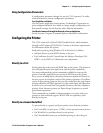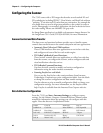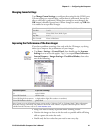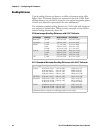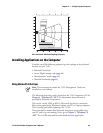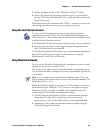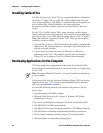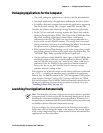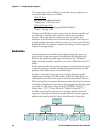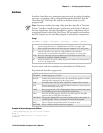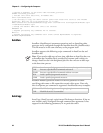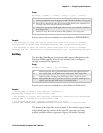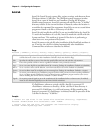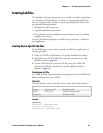
Chapter 3 — Configuring the Computer
751G Color Mobile Computer User’s Manual 47
Packaging Applications for the Computer
• You could package an application as a cabinet (cab) file. Recommended
• For simple applications, the application itself may be the file to deliver.
• It could be a directory structure that contains the application, supporting
files like ActiveX controls, DLLs, images, sound files, and data files.
Consider any of these when choosing a storage location for applications:
• In the 751G are two built-in storage options: the Object Store and the
Persistent Storage Manager (PSM). The Object Store is RAM that looks
like a disk. Anything copied here is deleted when a cold-boot is
performed on the unit. The PSM is an area of storage embedded in a
section of the system’s FLASH memory. This storage area is not erased
during a cold-boot, but it may be erased during the reflash. You also have
the option to store a persistent registry to the PSM region.
• If the optional Secure Digital storage card is in the system, then consider
this card the primary location to place applications installation files. The
“\SDMMC Disk” folder represents the Secure Digital card.
• Use the small non-volatile Flash File Store region to hold CAB files that
rebuild the system at cold-boot or install applications from a CAB file
into the Flash File Store so they are “ready-to-run” when a cold-boot is
performed. Since the FLASH in the system has a limited number of
write cycles, do not use the Flash File Store for excessive writing
purposes; however, reading is okay.
Files copied to any of these locations are safe when a cold-boot is performed
on a 751G — providing the AutoRun system is installed in the appropriate
location. You can find this system in the 751G Management Tools portion
of the Intermec Developer’s Library CD. Copying a cab file to the “\Flash
File Store\Persistent Copy\CabFiles” folder automatically extracts that cab
file on every cold-boot to ensure that your system is properly set up (see
“Installing Cabinet Files” on page 46).
Launching Your Application Automatically
You can configure the various media used in the Windows system with a
folder name and can change the media in the registry of the system. Many
of the startup components rely on folder names to locate information files,
applications, or other related data.
Note: This describes the system component startup for Intermec-provided
components only. It does not describe the bootstrap loader process. It only
describes the component installation process provided by Windows. It is
assumed that you understand the Microsoft Mobile startup procedures and
are familiar with how Microsoft components start up.



